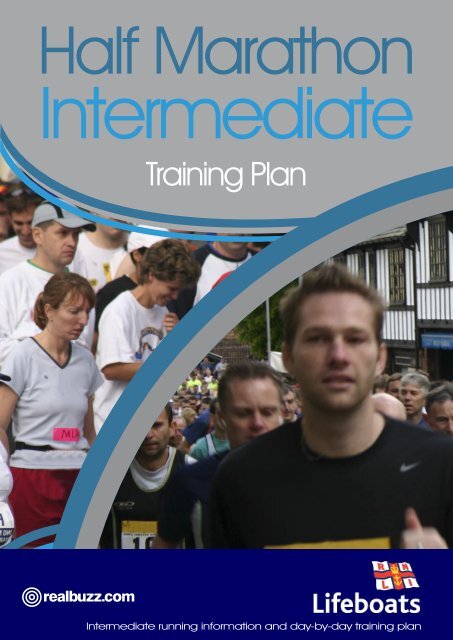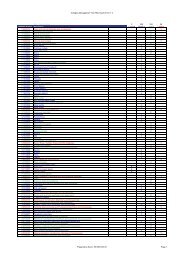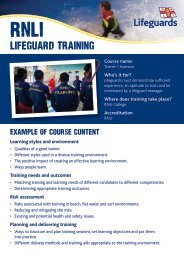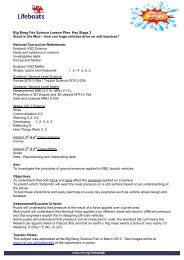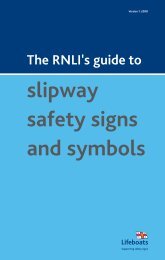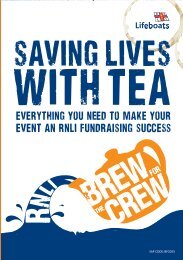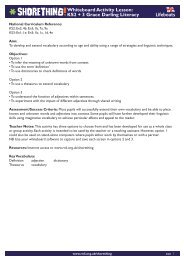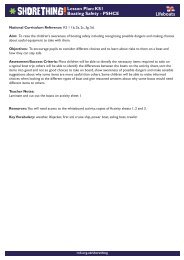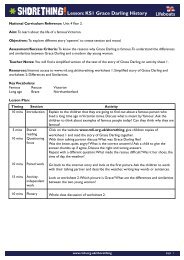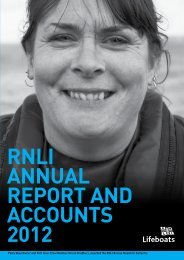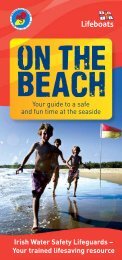Intermediate
Half Marathon Intermediate Training Plan - RNLI
Half Marathon Intermediate Training Plan - RNLI
You also want an ePaper? Increase the reach of your titles
YUMPU automatically turns print PDFs into web optimized ePapers that Google loves.
Half Marathon<strong>Intermediate</strong>Training Planrealbuzz.com<strong>Intermediate</strong> running information and day-by-day training plan
Half Marathon <strong>Intermediate</strong>Training PlanIntroductionThe world of runningRunning and jogging is a fantastic, energising, healthy and fun activity that caters for beginners and seasonedathletes alike and keeps you in shape! Running is enjoying a huge surge in popularity across all distances, from10k, half marathon, right through to the world famous Flora London Marathon. Some are huge mass participationspectacles with fields running into the thousands, others are small, local events with less than 100 competitors – buteach has its own special atmosphere. This training plan focuses on the half marathon, a distance that is not to betaken lightly because it is both a serious test of your fitness and your commitment to training. Covering 13.1 milesunder your own steam is a tremendous achievement and from beginning your training, to lining up at the start andfinishing; preparing for and completing a half marathon is a great experience.Who is this training plan for?This training plan is for you if you fall into one of the following categories:You have already completed one or more half marathon events and you are now looking to improve.You are training for your first half marathon but have a solid background of training and competing at shorterevents of at least 10k in distance, probably over 12 months or longer.The half marathon intermediate training plan focuses on everything you need to help you complete your event,sensible precautions to take and also contains a week-by-week structured programme that will progress you as ahalf marathon runner. This guide includes advice on:Training: the dos and don’ts of successful,safe training.Kit: what to buy and what to leave on the shelf.Footwear: how to choose the right training shoesfor you.Nutrition: how to correctly fuel your body.Hydration: when to drink, so that you don’t dehydrate.Training: a 12-week programme to prepareyou for your half marathon event.realbuzz.comIntroduction continued...3
Half Marathon <strong>Intermediate</strong>Training PlanWhat happens in a half marathon event?A half marathon is a hugely rewarding event to compete in. It serves both as an ideal introduction to longerdistance running and also a meaningful challenge in its own right. Completing a half marathon is a greatachievement wherever you finish in the field and this training plan steps you through to race day andincludes a multitude of tips and advice to help you reach your half marathon goal.If you’ve never watched or entered an event before, at first sight it appears to be chaotic, with hundreds oreven thousands of competitors arriving, warming up and generally preparing. The usual pattern of a race isas follows:1 ArrivalEvery entrant arrives at the race venue. Most events will have designated parking areas and largerraces will have a public address system to keep everyone updated as the start time approaches.2 PreparationAs the race start time gets nearer, competitors will be making final adjustments to their kit, visiting thetoilet and warming-up – so that they are fully prepared for their race.3 Lining upEveryone lines up according to their expected finishing time, with the faster runners right on the startline and those expecting to finish later, further back. This way, no-one is impeded.4 StartA gun, klaxon or similar is sounded and the race begins. Unless you are right on the start line, progresswill be slightly slower as the runners in front get away – which is often a good thing becauseyou’re not tempted to begin to quickly, which can ruin your race.realbuzz.comIntroduction continued...4
Half Marathon <strong>Intermediate</strong>Training Plan5 Main raceOver the duration of the race there will usually be kilometre or mile markers every kilometre or mile,so that you can monitor your pace frequently and drinks stations for re-hydrating on route.6 FinishThe finish line will be clearly marked, usually with a gantry or banner and a time clock.7 Post finishRunners are grouped into finishing funnels where medals/t-shirts etc are given out (depending on the race)and drinks are also usually available.Before you begin . . .Before you start that first training session, it is important to take a little time out to check a few safetyconsiderations before you commence half marathon training.Safety firstTo start with, it is vitally important to ensure that it is safe for you to begin an exercise programme. Complete thesafety checklist below and if you answer YES to one or more questions, or alternatively, if you are at all concernedabout starting training, then make an appointment with your doctor for a check-up before you start.Health-status safety checklist:1 Are you aged over 30 and/or have not exercised for some time? Y/N2 Do you suffer from any medical conditions? Y/N3 Are you a smoker or have recently given up smoking? Y/N4 Have you undergone any surgery in the past two years? Y/N5 Are you suffering from any injuries? Y/N6 Are you currently on any prescribed medication? Y/N7 Are you unsure about beginning an exercise programme? Y/NOnce you have the all-clear from your doctor then you’re ready to step out on the road to half marathon fitness.realbuzz.com 5
Half Marathon <strong>Intermediate</strong>Training Plan1 Getting startedWhat gear do I need?To get started on your road to half marathon fitness, you need minimal equipment. Running is a very simplesport and requires very little specialist kit. The most important point is that you have suitable clothing (particularlyfootwear) and that you feel comfortable in everything. The most technical and most important thingsyou need to buy are your running shoes. These have evolved over the past ten years into sophisticatedpieces of technology of which each manufacturer has developed their own version.ShoesCorrect footwear is one area where you should not compromise. Good running shoes are aninvestment in comfort, protection and injury prevention and it is worth visiting a specialist sportsfootwear retailer rather than a chain store and discussing your requirements with them. A specialistretailer with gait analysis and pressure plate testing will be able to assess your requirements andrecommend suitable shoes for your particular gait and running style. Good shoes will last and yourinitial investment will be repaid many times over and if you calculate the ‘pence-per-session’ cost ofyour shoes, you will find them extremely good value.realbuzz.comYou want to be comfortable when you run, so finding the correct shoe sizeis very important. When you shop for running shoes, always go in the afternoon because afterlunch, your feet will have expanded a little. Hence a snug fit in the morning could mean atight fit in the afternoon and blisters when training, which is certain to curb your enthusiasm!realbuzz.comGetting started continued... 6
Half Marathon <strong>Intermediate</strong>Training PlanSocksWorking upwards from the shoes, next you need some socks to train in. These can be simple whitesports socks that can be picked up from most sports stores. However, if you get more serious aboutyour running, it is wise to invest in some socks that have been specifically designed for running. Thesehave been designed to wick away moisture and sweat from the foot so you don’t slip and consequentlysuffer from blisters. Additionally, these types of socks are designed with more padding in certain areasfor enhanced cushioning.The most advanced socks are designed for the appropriate foot i.e: they are left and right foot specific.The specific foot socks have a great benefit in that they hug the foot better and there is no excess sockfloating around in the shoe which may cause blisters. As with most things nowadays, you get what youpay for and a £1 pair of socks won’t give you as much comfort as an £8 pair.realbuzz.comBuy your socks before you buy your shoes!Socks come in a wide range of thicknesses,which can significantly affect the fit of yourrunning shoes. Take the socks that you aregoing to train in along to the shoe retailer sothat you get a perfect match.realbuzz.comGetting started continued... 7
Half Marathon <strong>Intermediate</strong>Training PlanShorts and tightsAfter socks come shorts or when it is colder, tights. Shorts should be comfortable, lightweight and have theability to wick away sweat when you train. Most running shorts now come with a pant liner so you don’t haveto wear anything else with them. This is good but you have to try them on first as some of the inners can bea little restrictive if you don’t get the right size. Most shorts come with elastic waist bands and the moreexpensive ones come with a drawstring as well. It is worth paying a little extra to get the drawstring as youcan tie the shorts to your specification as opposed to relying on the elastic to hold them up.Elastic-only shorts often move down a little, especially in wet conditions. Your shorts shouldn’t be so tight thatthey cut off circulation round your waist but conversely they shouldn’t be so loose that they flap around allthe time either. Finally, check the slit up the side, often this is quite large to allow for a greater ventilation andfreedom of movement but make sure you are happy with how much leg it actually shows when you run!When the weather is colder it is advisable to wear tights to keep your legs warmer and thus reduce thechance of injury. Fabric technology has exploded recently with the aid of new synthetic materials and NASAtechnology. This has aided running no end with high-tech materials filtering down to basic running kit liketights and t-shirts. The running tights are available which hug the legs more efficiently and stop the wind andrain penetrating to the leg itself. This helps in reducing injuries from cold muscles and also means that youcan enjoy running when the weather is a little worse than ideal. Only diehard older runners now wear loosefitting cotton tights.The fashionable and technological knowledgeable runners are choosing high tech garments that helpthem in their running. Your tights should be snug fitting and comfortable. It is important to try them on beforeyou buy because many manufacturers have different cuts to suit different styles of runner. Generally, themore expensive the tight, the more comfortable they will be and the better at keeping you coolin summer and warm in winter.realbuzz.comGetting started continued... 8
Half Marathon <strong>Intermediate</strong>Training PlanTopsShort and long-sleeve t-shirts have also benefited, like tights, from technological advances. The mid to toprange t-shirts all wick away sweat to keep you cooler and allow a greater air circulation through the fabric.They feel very lightweight but have the properties to keep you warm or cool depending on when andhow you wear them. Running t-shirts should be reasonably tight but not figure-hugging and likewise theyshouldn’t flap around when you run in them. It is a fine balance between well fitted and slightly baggy thatyou should aim for. With long-sleeve t-shirts, you should aim to get ones with cuffed sleeves so they staydown around your wrists. If there are no cuffs then the sleeves often ride upyour arms when you run and this can be both annoying and cold.Similarly, for hot weather training, vests are also designed withtechnological, wicking fabrics that also help air circulate around yourbody to aid cooling.When the weather gets really cold or wet it is advisable to run in a gillet or a long-sleeve waterproof top.These offer excellent wind-stopping and rain-resistance capabilities and can keep you warm and drythroughout any run. Gillets are sleeveless jackets and ideal for quicker running in slightly warmer climateswhile full long-sleeve waterproofs are better for colder and wetter climates. These types of tops aremulti-purpose because they can be used casually as well and the ones at the top end are very high techand guaranteed waterproof and windproof. Cheaper versions will be fine for most running conditions butthey will sacrifice certain aspects like being 100% waterproof or windproof. Being prepared for coolerconditions enables you to stay warm, dry and enjoy the run more. In warmer climates the new fabricsand technologies enable you to train harder by staying cooler and wicking away sweat and moisturefrom the body. Both of these mean you can’t blame the weather for not training anymore andyou can get and stay fitter all year round now in comfort and style.realbuzz.comGetting started continued... 9
Half Marathon <strong>Intermediate</strong>Training PlanGlovesThese should be lightweight and comfortable. Only in extreme weather will you need to wear thickrunning gloves and more often than not you will heat up enough to be okay in the normal thin type.Woollen gloves are the norm because they are cheap to buy, but they don’t offer the same waterproofand wind stopper capabilities of the new high-tech fabrics. Woollen gloves will be fine for most runnersbut if you are venturing out into colder or wetter climates, it is worth investing in a high-tech pair.Running with cold hands can ruin the experience for you, so choose carefully when you buy, especiallyif it is near wintertime.HatsHats are similar to gloves in that woollen ones are the norm because they are easy to get hold of andare cheap. The more high-tech versions such as those made of fleece, offer wind-stoppingcapabilities and some are waterproof as well. Caps offer greater protection from the rain, snow andsun but often they can get blown off in windy conditions. They don’t offer the same warmth capabilitiesas woollen/high tech fabrics but they are good when you need better protection from the elements. Inaddition, they are better for runners who wear glasses because they help the glasses from getting rainor snow on.realbuzz.comGetting started continued...10
Half Marathon <strong>Intermediate</strong>Training PlanSports brasIt is important to wear a sports bra that fits you snugly and gives adequate support for running. The bustis only held in place by the skin around it and the Coopers Ligaments and when the bust moves, theseligaments can stretch result in a permanent droop. In addition, this movement can be painful and leadsmany women to avoid certain activities that could be enjoyed with a good sports bra. Everyone isdifferent and you may well need to try on a few different products before finding what is just right for you.So does your sports bra fit?Your bra should fit snugly under the bust without being uncomfortably tight.All of your bust should fit in the bra without any bulges around the sides.The shoulder straps should not dig in (for larger busts wider straps are more comfortable).When you run there should be significantly less bounce than with a normal braMost ladies should only need to wear one sports bra even for high impact activities.There are many excellent bras on the market, which come in a large range of sizes and coloursoffering every different level of support.realbuzz.com11
Half Marathon <strong>Intermediate</strong>Training Plan2 TrainingWhere to trainWith walking, jogging and running, virtually nowhere is out of bounds. Fromtreadmills at the gym to the great outdoors, the possibilities are endless.Some people never venture from the roads whilst others train almostexclusively on paths, trails and in local parks, the choice is yours. A sensibleapproach is to start locally and then venture further afield as you progress.That way, when building up, you are never far from home. Varying yourroutes is a must – even the most committed runner tires of following thesame circuit session after session, so use your local knowledge to keep yourruns fresh.When to trainFrom early morning through to lunchtime and late evening, everyone hastheir favourite time to exercise, and training time flexibility is one of thegreat plusses with running – you can always train at a time to suit you.Physiologically, early afternoon has beenfound to be the best time to train; therealbuzz.comIf you train first thing in the morning,body is fully woken up and loose andhas had the opportunity to be wellfuelled and hydrated. However, if forexample midnight is the most suitable fitfor your circumstances, there’s nothing toas well as a great start to the day, you really boost yourmetabolic rate (the speed at which your body burnscalories). This takes effect during your session and forseveral hours afterwards, which is a great weightmanagement strategy.stop you training whenever you wish.realbuzz.com 12Training continued...
Half Marathon <strong>Intermediate</strong>Training PlanPrinciples of trainingIt is common to think that when a training improvement is made (for example running further or running afaster time over a particular distance), that the improvement has been made at that specific time. In fact thatis not the case; the improvement has been made some time previously, following an earlier training session.During the training session, it is the measurable results that are registered in the form of quicker times or furtherdistances. This is because of the way the body responds to training. When exercising, the body is challenged.Following a training session, when the body is at rest, it adapts and gets stronger, and improvements can bemeasured during a subsequent session. Hence the most important component of any training programme isrest, so that the body is able to adapt to training. Inadequate rest can result in excessive fatigue, loss ofmotivation and at worst, injury.Structuring your training sessionsFollowing correct exercise protocols is key to getting the most out of your training, so that you start out on theroad to fitness with safe and correctly balanced training sessions. To get the most out of your training, youshould adhere to the following sequence each time you train:Warm-upThe warm-up, raises the heart-rate, gets blood flowing to the working muscles and prepares the body forexercise. It should be for a minimum of five minutes and replicate the movements or activities of the mainsession.As a general rule, your warm-up should last for approximately ten minutes. The warm-up should be of asufficiently high intensity to make you start to perspire and elevate your heart rate but not so intense that itis as challenging as your main session or detracts from the quality of your session.For example: when beginning a run, ten minutes very easy jogging will prime the body for themain training session.realbuzz.comTraining continued...13
Half Marathon <strong>Intermediate</strong>Training PlanMobilitySome basic actions to put the limbs through the range of movement that the main session requires willensure that the joints are loosened up, lubricated and will function more efficiently.Main sessionThis will form the bulk of the training session. For example: a brisk 15 minute run.Cool-downThe cool-down should be at a lower intensity than the main session and should bring the bodytemperature and heart rate closer to pre-exercise levels. Waste by-products of exercise will be flushedfrom the muscles and tissues, accelerating recovery before the next training session.For example: the cool-down should be a minimum of 5-10 minutes light CV.Jogging or walking is ideal.FlexibilityStretching exercises should be carried out after the main sessionand cool-down as the body is in a greater state of relaxationthan at the beginning of the session. 5-10 minutes spentstretching the muscles worked will maintain suppleness.realbuzz.com 14Training continued...
Half Marathon <strong>Intermediate</strong>Training PlanHow to stretchPlease try these simple stretches.1 ShoulderRotate your shoulders both individually then together,forwards and backwards for 20 to 30 seconds each.Then pull your arm back over your head and gentlypull the elbow down towards the back. Repeat withboth arms and hold for 10 seconds each.2 BackTilt your pelvis upwards, while bendingyour knees slightly. Arms out frontaway from your chest, interlock yourhands, palms facing outwards. Roundyour upper back and tilt your head to lookChest3Place your hands on the smallof your back and try to moveyour elbows towards eachother behind your back.Hip and thighdown. Feel the stretch in your back.Lying on your back, bring a knee in as close aspossible to your chest, keeping your other legstretched out on the floor.Repeat with the other leg.4Quadriceps5Standing up, pick up yourright ankle. Ease your footinto your buttocks usingyour right hand. Repeatwith your left leg.CalfFind a wall, tree or car to lean on and get in a positionto push it over. Keep the feet about shoulder widthapart and the rear leg straight. Lean the hipstowards the tree, wall or car. Alternate legs andhold for 10 seconds each.67Spine and trunkSit on your bottom with your legs stretched out. Raise your right foot and place it on the floor tothe left of your left knee while stretching your upper body around to the right. Use your leftarm as a lever to ease around as far as you can. Repeat with your left foot.Keep your spine long, as well as your shoulders down as you do this.realbuzz.com 15Training continued...
Half Marathon <strong>Intermediate</strong>Training PlanTo get the most out of your post exercise stretching session,simply follow the step-by-step guide below:RelaxIt is very important to be relaxed. Physical and mentaltension will inhibit your range of movement and preventyour muscles from stretching as effectively. Hence, you willnot achieve maximum flexibility benefits.Ease into the stretchGradually move your body or the limb being stretchedinto the stretch position. Once you feel slight tension in themuscle, (known as the point of bind), which is the limit of themuscle’s flexibility, hold the position. Avoid bouncing or anyother movements, which could overstretch the muscle andresult in injury.Relax your breathingAlways keep your breathing easy and relaxed because thatwill reduce all-round muscular tension, which in turn willallow you to stretch further. Holding your breath will tense upyour entire body, making stretching much harder.realbuzz.com 16Training continued...
Half Marathon <strong>Intermediate</strong>Training PlanHold for 30 secondsTo get maximum stretching benefits, you need to hold the stretch for a minimum of 30 seconds. Stretchingeach muscle for just a few seconds brings no flexibility benefits.Pain means no gainStretching should invoke a mild feeling of ‘tightness’ or tension within the stretched muscle. Pain whenstretching indicates injury or a muscle that has been overstretched. Therefore, never stretch beyond a‘comfortable tightness’.Rest and repeatA single stretch for each muscle is very beneficial but if time permits, carry out two stretches for eachmuscle, separated by a short break of 30 seconds. The second stretch will help extend your rangeof movement further.FrequencyIdeally, stretch the major muscles after every run but if that proves too time-consuming, stretching twice aweek is a suitable target.realbuzz.com 17
Half Marathon <strong>Intermediate</strong>Training Plan3 Nutrition and hydrationFuelling your training correctly and keeping well hydrated is extremely important and good nutrition will enhanceyour running experience. Nutrition and hydration are enormous subjects and are dealt with more comprehensivelyin the downloadable realbuzz.com guide, Get into… healthy eating and hydration. However, to kick-start yourhealthy nutrition plan, try and follow the five golden rules below:Five golden nutrition and hydration rules1. Always eat breakfastYour body needs good quality fuel for training and by waking up your metabolismafter sleep; you actually burn more calories through the day.2. Leave a gapAllow 1 ½ to 2 ½ hours between your last meal and your training session to allow for digestion. Exercising on a fullstomach will not only feel uncomfortable but will also inhibit your performance.3. HydrateDrinking water regularly throughout the day is important, but because you are exercising, your fluidrequirements will be greater due to sweat losses. However, you will need to focus more on hydration and drinkingstraight after your workout.4. RefuelYour energy requirements will increase as your training increases and the optimum time to begin your refuelling isimmediately after your workout. Always try and eat something (a banana is great) as soon as possible after yourcool-down.5. Don’t neglect proteinInclude good quality protein in your diet to support rebuilding because your body will need more tomatch the increased demands that you are placing on your body.realbuzz.com 18
Half Marathon <strong>Intermediate</strong>Training Plan4Half Marathon <strong>Intermediate</strong>Training PlanPlan notesThe key to successful training is to build gradually. Everyone progresses at a different rate and your bodytakes time to adapt to the new demands that you make on it. Hence, it is important not to allow yourenthusiasm to over-ride the components of a correctly structured training programme and to alwaysallow sufficient rest and recovery between sessions. If you are tired and feel like a couple of days off thenyour body is probably telling you to step back a little. Of course if you feel like missing your run becausethere’s something good on TV then that is a different scenario altogether! Always maintain overall balancebetween, work, family and other commitments and your training so that running enhances your life, notdominates it.The programme focuses on building your half marathon running specific fitness over 12-weeks so that at theend of the programme, you are ready for your event. The plan is progressive but you can jump in at aposition that matches your current training load if you are already training. After that it’s up to you! realbuzz.com produce a wide variety of training plans that can help you progress your half marathon fitness orperhaps move up to the challenge of the marathon!realbuzz.comDon’t be a slave to the programme! The training planis designed with rest days, recovery sessions and lower volume weeks. Thiswill ensure your body has time to adapt to the training. However, everyoneis different and if you feel that an extra days rest will be beneficial to yourtraining, simply take out one of the shorter sessions in that week.realbuzz.com 19Half Marathon <strong>Intermediate</strong>Training Plan continued...
Half Marathon <strong>Intermediate</strong>Training PlanTraining pace guideUse the pace guide below to monitor your pace throughout each week of the 12-week plan.Type of Intensity index Descriptiontraining run 1=incredibly easy10= incredibly hardSuper slow 2 Really, really, slow; so easy it hardly seems worthputting your kit on!Easy jog 3 No pressure, just loosening up or a recovery run.Jog 4 Still an easy pace but a little faster than an easy jog.Comfortable 5 You can chat easily to your training partner and thekeep the pace going.Steady 6 Even paced run, can chat in short sentences.Brisk 7 Slightly breathless pace, not easy to hold aconversation with your training partner.Hard 8+ You certainly know you’re working, conversation isdefinitely out!Half Marathon <strong>Intermediate</strong>Training Plan continued...realbuzz.com 20
Half Marathon <strong>Intermediate</strong>Training PlanHalf Marathon <strong>Intermediate</strong> Training PlanWeek 1 Getting started (1)Week 2 Getting started (2)Day Training Training notesDay Training Training notesMon30 mins steadyMon30 mins easyTues 50 mins with effortson hillsWed RestThurs 30 mins easyFri Warm-up, brisk 25 Good stretch atmins, cool-down the end.Sat RestSun 60 mins comfortablepaceWeek 3 Building (1)Day TrainingTraining notesMon Easy 30 mins jog. Avoid temptation torun quickly.Tues Repeat lastWednesday’s qualitysession.Wed RestTues Steady 50 minsWed Warm-up then 3 x 7minutes hard with 3minute recoveries,cool-downThurs RestFri Steady 45 minsSat RestSun 60 mins steady. Repeat of last Sundaybut a little quicker.Week 4 Building (2)Day TrainingTraining notesMon RestTues Steady 45 minsWed Brisk 60 minutes,working hard on hills,recovering on downhills.Thurs Steady 50 minsFri Warm-up, then 20-25mins fast time-trial,cool-downSat RestSun 70-75 mins comfortableThurs Easy 30 mins recoveryFriSatSunjog.Steady 45 minsRest80 mins comfortablepaceTake it very easy.realbuzz.com 21Half Marathon <strong>Intermediate</strong>Training Plan continued...
Half Marathon <strong>Intermediate</strong>Training PlanWeek 5 Mid-schedule peakWeek 6 Taper and mini target raceDay TrainingTraining notesDay TrainingTraining notesMon Easy 30 min jogTues Warm-up, 2 x 10 mins Finish with somehard with 4 mins stretchesrecovery between,then cool-down.Wed RestThurs Repeat time-trial from Try and improve onweek 3.time.Fri Steady 50 minsSat RestSun 90 mins comfortableWeek 7Mon Easy recovery 30 Back off week leadingminsto a tester race.Tues Warm-up, brisk 20-25mins, cool-down.Wed RestThurs Steady 45 minsFri RestSat 15 minutes super slowSun 10k race. Warm-up, Stretch all leg musclesrace hard then afterwardscool-down.Week 8Day TrainingTraining notesDay TrainingTraining notesMon Very easy 20-25 Purely recovery runningmins jog.Tues Steady 40 mins.Wed Warm-up then 3 x 7minutes hard with 3minute recoveries,cool-downThurs RestFri 50-60 mins steadySat RestSun 100 mins comfortable Sunday run returns tolonger distances.Mon Easy recovery 30 minsTues Warm-up, 3 x 10 mins Finish with somehard with 4 mins stretchesrecovery in between, An extra 10 minutecool-down.hard effort this week.Wed RestThurs Steady 45 minsFri Repeat time-trial from Big effort. Try andweeks 3 and 5. improve on week 5times.Sat RestSun 110 mins jog – Easy pacecomfortable throughoutHalf Marathon <strong>Intermediate</strong>Training Plan continued...realbuzz.com 22
Half Marathon <strong>Intermediate</strong>Training PlanWeek 9Day TrainingTraining notesMon Steady 40 minsTues Warm-up, 6 x 3 minswith 2 mins recovery,cool-down.Focus on equal efforteach time.Week 10 Peak weekWed Steady 45-50 minsThurs Warm-up, brisk 30 mins,cool-down and stretchDay TrainingMon Easy 30 mins recoveryrunTraining notesFri RestSat Easy 20 minute jogSun 120 mins easy Take it slow, just focuson completion.Tues Warm-up then 3 x 7 Shorter recoveries thisminutes hard with 2½ week.minute recoveries,cool-downWed RestWeek 11 Start of taperDay TrainingMon Easy 20 minute jog.Tues Steady 40 minsWed RestThurs 45-50 mins with briskefforts on hillsTraining notesThurs 60 minutes with hardefforts on every hill.Fri RestSat 10 mins easy jog Very, very easy; bigrun tomorrow.Sun Minimum 120 mins, Last long trainingaim for 130 mins run, taken very easy.FriSatRestEasy 15 minute jogSun 60 mins comfortable Avoid temptation towith 20 minutes brisk do more.in the middle.realbuzz.com 23Half Marathon <strong>Intermediate</strong>Training Plan continued...
Half Marathon <strong>Intermediate</strong>Training PlanRace week preparationThe focus for your final week before your event should be relaxing and doing easier sessions as you gatheryour energy for your race. Competing in a race requires some planning and organisation so that you canproduce your best performance, rather than get caught up in traffic jams or missing key items of kit. Useyour extra free time in the final week to plan and prepare for your big day. To make sure that your race goeswithout a hitch, follow our top race tips below:1. Assemble and check all your kit early on in the finalweek.Week 12 Taper week and RACE!Day TrainingTraining notesMon 20 mins easy jog Very easy pace2. Don’t experiment with new kit items on race day, stickwith tried, trusted and broken in items so that you avoidany unplanned chafing problems.Tues RestWed 40 mins comfortablebrisk with 5 x 20second brisk efforts.your system.Brisk efforts keepyour speed tunedup without taxing3. Eat your usual meals on race day, just as if it was anormal training run. Now is not the time to experimentwith new energy drinks!Thurs Steady 30 minsFri RestSat 10-15 mins super slow Super slowin race kit and shoes4. Take a box of ‘emergency items’ such as spare lacesand a couple of old t-shirts in case the weather is poorwhilst you are warming-up.SunHalf marathon race!with easy warm-upand cool-down5. Check over the race organiser’s instructions and route descriptions so that you are familiar with allarrangements.6. Arrive at the race venue early. By arriving early, you can settle in and check out the start andfinish, which will give you the best chance of enjoying your race experience.realbuzz.com 24
Half Marathon <strong>Intermediate</strong>Training PlanConclusionWell done!You have come to the end of the schedule, and your fitness has improved dramatically as you’veincreased your training towards race day. Along the way, you have made significant health andfitness gains, and equally importantly, you have progressed safely. By maintaining your training, youwill be making a major contribution to your long-term health and fitness and this schedule can alsoserve as a foundation and springboard to increase your fitness levels further. Now you’ve completedyour race, you may be thinking about improving your time further or you might be tempted to stepup in distance, perhaps to a full marathon. See one of the realbuzz.com marathon training plans fortraining programmes that will help you move on up.Enjoy your training!DisclaimerNeither realbuzz.com or its associated companies can accept any responsibility for death or injuriescaused by any information contained within. All information is provided in good faith. You should consultyour doctor before embarking on any programme of physical activity.By using this information you agree to indemnify, defend, and hold us harmless from and against anyclaims, actions, demands or other proceedings brought against us by a third party, to the extent thatsuch claim, suit, action or other proceeding brought against us is based on or arises in connection withyour use of the pack, any breach by you of these terms and conditions or a claim that your use of thepack infringes any intellectual property rights of any third party or is libellous or defamatory, or otherwiseresults in injury or damage to any third party.realbuzz.com25


